Rescue operations, Restoring communication services, Medical assistance, Farming practices restarted.
Farming practices restarted
Farming practices are restarted during the reconstruction phase, whereas the rest are part of phase of emergencey.
Topper's Solved these Questions
- DISASTER MANAGEMENTBOOK - TARGET PUBLICATIONCHAPTER - DISASTER MANAGEMENTEXERCISE - COMPLETE THE ANALOGY
4 Videos
- DISASTER MANAGEMENTBOOK - TARGET PUBLICATIONCHAPTER - DISASTER MANAGEMENTEXERCISE - ANSWER THE FOLLOWING
32 Videos
- DISASTER MANAGEMENTBOOK - TARGET PUBLICATIONCHAPTER - DISASTER MANAGEMENTEXERCISE - TRUE OR FALSE
12 Videos
- EFFECTS OF ELECTRIC CURRENT BOOK - TARGET PUBLICATIONCHAPTER - EFFECTS OF ELECTRIC CURRENT EXERCISE - Solve the following problems
26 Videos
Similar Questions
Various actions like search and rescue operations, medical assistance, first aid, restoring communication services, removing the people from affected area are expected in the.........
View SolutionDecentralisation: A Strength
The McNeil name has been associated with the manufacturing and sale of pharmaceutical products since 1870, when Robert McNeil opened his first retail drug outlet in Pennsylvania. Growing as a producer of prescription pharmceuticas, McNeil Laboratories, lnc. was incorporated in the U.S. in 1933, and became a member of the Johnson & Johnson family of companies in 1959. McNeil Consumer Helathcare began operations in Canada in an existing administrative Johnson & Johnson facility in Guelph, Ontario in 1980.
McNeil Consumer Healthcare (nonprescription pharmaceutical products) in Guelph, Ontario is a member of the Johnson & Johnson family of companies in Canada.
An important difference between Johnson and most other companies - is the concept of decentralised management. Instead of operating as one large multi-billion dollar corporation, Johnson & Johnson is operated as 190 smaller companies, each focused on a specific medical or product franchise and/or geographic area, with each affiliate generating multiple options for growth. Through decentralisation we combine the advantages of being big with the agility and focus of smaller firms. Decentralisation enables each company to stay close to its customer, maintain short lines of communication with customers and employees, and accelerate the development of talent. The Johnson & Johnson - Merck Consumer Pharmaceuticals company also operates from our Woodlawn Road facility in Guelph.
On the basis of the above paragraph, define Decentralised Organisation.
View Solution
Knowledge Check
Andrew begun his medical practice as an assistance to Dr.—
ACharles Rage,BEdward Manson,CCharles Manson,DEdward Page.The Physician Assistant Will See You Now
23 The term “paramedics” refers to health care workers who provide routine and clinical services.–––––––––––––––––––––––––––––––––––––––––––––––––––––––––––––––––––––––––––––––––––––––––––––––––––––– While the pressures of an aging population, insurance reforms, and health epidemics have increased demand for care, the supply of physicians is not expected to 24 keep pace.––––––––––– The Association of American Medical Colleges predicts a shortage of over 90,000 physicians by 2020, by 2025, that number could climb to more than 130,000. In some parts of the country, shortages are already a sad fact of life. A 2009 report by the Bureau of Health Professions notes that although a fifth of the US population lives in rural areas, less than a tenth of US physicians serves that population. Because a traditionalist response to the crisis— 25 amping up–––––––––––– medical-college enrollments and expanding physician training programs—is too slow and costly to address the near-term problem, alternatives are being explored. One promising avenue has been greater reliance on physician assistants (PAs).
26 By virtue of 27 there–––––– medical training, PAs can perform many of the jobs traditionally done by doctors, including treating chronic and acute conditions, performing minor 28 surgeries: and––––––––––––––– prescribing some medications. However, although well 29 compensated earning in 2012 a median annual salary of $90,930,––––––––––––––––––––––––––––––––––––––––––––––––––––––––––––––––––––– PAs cost health care providers less than do the physicians who might otherwise undertake these tasks. Moreover, the training period for PAs is markedly shorter than 30 those for–––––––––– physicians—two to three years versus the seven to eleven required for physicians.
Physician assistants already offer vital primary care in many locations. Some 90,000 PAs were employed nationwide in 2012. Over and above their value in partially compensating for the general physician shortage has been their extraordinary contribution to rural health care. A recent review of the scholarly literature by Texas researchers found that PAs lend cost-efficient, widely appreciated services in underserved areas. 31 In addition,––––––––––––– rural-based PAs often provide a broader spectrum of such services than do their urban and suburban counterparts, possibly as a consequence of the limited pool of rural-based physicians.
Increasingly, PAs and other such medical practitioners have become a critical complement to physicians. A 2013 RAND Corporation report estimates that while the number of primary care physicians will increase slowly from 2010 to 2025, the number of physician assistants and nurse-practitioners in primary care will grow at much faster rates. 32 Both by merit and from necessity, PAs are likely to greet more 33 patience than––––––––––––––– ever before.
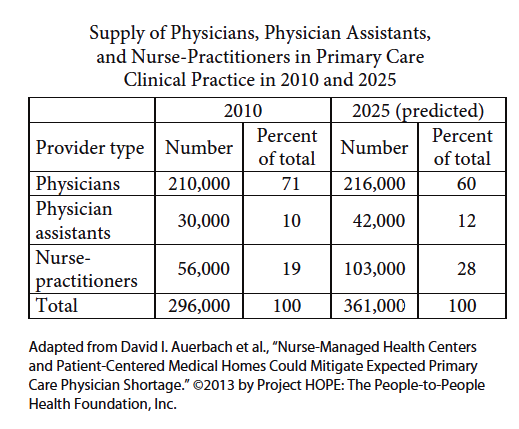 ANO CHANGEBmaintain the tempo.Cget in line.Dmove along.
ANO CHANGEBmaintain the tempo.Cget in line.Dmove along.The Physician Assistant Will See You Now
23 The term “paramedics” refers to health care workers who provide routine and clinical services.–––––––––––––––––––––––––––––––––––––––––––––––––––––––––––––––––––––––––––––––––––––––––––––––––––––– While the pressures of an aging population, insurance reforms, and health epidemics have increased demand for care, the supply of physicians is not expected to 24 keep pace.––––––––––– The Association of American Medical Colleges predicts a shortage of over 90,000 physicians by 2020, by 2025, that number could climb to more than 130,000. In some parts of the country, shortages are already a sad fact of life. A 2009 report by the Bureau of Health Professions notes that although a fifth of the US population lives in rural areas, less than a tenth of US physicians serves that population. Because a traditionalist response to the crisis— 25 amping up–––––––––––– medical-college enrollments and expanding physician training programs—is too slow and costly to address the near-term problem, alternatives are being explored. One promising avenue has been greater reliance on physician assistants (PAs).
26 By virtue of 27 there–––––– medical training, PAs can perform many of the jobs traditionally done by doctors, including treating chronic and acute conditions, performing minor 28 surgeries: and––––––––––––––– prescribing some medications. However, although well 29 compensated earning in 2012 a median annual salary of $90,930,––––––––––––––––––––––––––––––––––––––––––––––––––––––––––––––––––––– PAs cost health care providers less than do the physicians who might otherwise undertake these tasks. Moreover, the training period for PAs is markedly shorter than 30 those for–––––––––– physicians—two to three years versus the seven to eleven required for physicians.
Physician assistants already offer vital primary care in many locations. Some 90,000 PAs were employed nationwide in 2012. Over and above their value in partially compensating for the general physician shortage has been their extraordinary contribution to rural health care. A recent review of the scholarly literature by Texas researchers found that PAs lend cost-efficient, widely appreciated services in underserved areas. 31 In addition,––––––––––––– rural-based PAs often provide a broader spectrum of such services than do their urban and suburban counterparts, possibly as a consequence of the limited pool of rural-based physicians.
Increasingly, PAs and other such medical practitioners have become a critical complement to physicians. A 2013 RAND Corporation report estimates that while the number of primary care physicians will increase slowly from 2010 to 2025, the number of physician assistants and nurse-practitioners in primary care will grow at much faster rates. 32 Both by merit and from necessity, PAs are likely to greet more 33 patience than––––––––––––––– ever before.
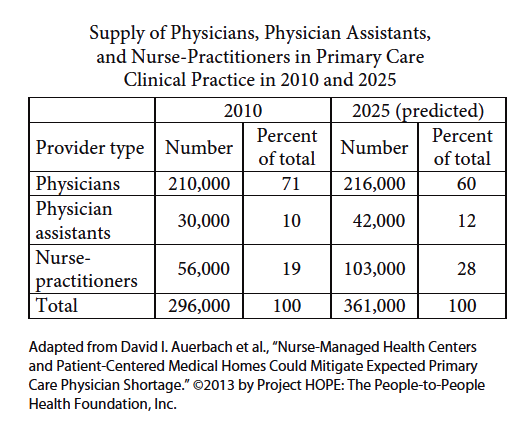 ANO CHANGEBsurgeries, andCsurgeries, and,Dsurgeries, and
ANO CHANGEBsurgeries, andCsurgeries, and,Dsurgeries, and
Kavita recently joined as the human resources director of Arjun Vidyanmandir School, a senior secondary educational institute. She observed that the school had an experincd medical team on its payrol. They regularly offered useful suggestion which were neither appreciated nor rewarded by the school authorities. Instead the school outsourced the tasks of maintenance of health records of the students and paid them a good compensation for their services. Because of this, the existing medical team fell disheartened and stopped giving useful suggestions.
a) Identify the communications barrier discussed above.
b) State the category of this communication barrier.
c) Explain any other two communication barriers of the same category.
View SolutionThe Physician Assistant Will See You Now
23 The term “paramedics” refers to health care workers who provide routine and clinical services.–––––––––––––––––––––––––––––––––––––––––––––––––––––––––––––––––––––––––––––––––––––––––––––––––––––– While the pressures of an aging population, insurance reforms, and health epidemics have increased demand for care, the supply of physicians is not expected to 24 keep pace.––––––––––– The Association of American Medical Colleges predicts a shortage of over 90,000 physicians by 2020, by 2025, that number could climb to more than 130,000. In some parts of the country, shortages are already a sad fact of life. A 2009 report by the Bureau of Health Professions notes that although a fifth of the US population lives in rural areas, less than a tenth of US physicians serves that population. Because a traditionalist response to the crisis— 25 amping up–––––––––––– medical-college enrollments and expanding physician training programs—is too slow and costly to address the near-term problem, alternatives are being explored. One promising avenue has been greater reliance on physician assistants (PAs).
26 By virtue of 27 there–––––– medical training, PAs can perform many of the jobs traditionally done by doctors, including treating chronic and acute conditions, performing minor 28 surgeries: and––––––––––––––– prescribing some medications. However, although well 29 compensated earning in 2012 a median annual salary of $90,930,––––––––––––––––––––––––––––––––––––––––––––––––––––––––––––––––––––– PAs cost health care providers less than do the physicians who might otherwise undertake these tasks. Moreover, the training period for PAs is markedly shorter than 30 those for–––––––––– physicians—two to three years versus the seven to eleven required for physicians.
Physician assistants already offer vital primary care in many locations. Some 90,000 PAs were employed nationwide in 2012. Over and above their value in partially compensating for the general physician shortage has been their extraordinary contribution to rural health care. A recent review of the scholarly literature by Texas researchers found that PAs lend cost-efficient, widely appreciated services in underserved areas. 31 In addition,––––––––––––– rural-based PAs often provide a broader spectrum of such services than do their urban and suburban counterparts, possibly as a consequence of the limited pool of rural-based physicians.
Increasingly, PAs and other such medical practitioners have become a critical complement to physicians. A 2013 RAND Corporation report estimates that while the number of primary care physicians will increase slowly from 2010 to 2025, the number of physician assistants and nurse-practitioners in primary care will grow at much faster rates. 32 Both by merit and from necessity, PAs are likely to greet more 33 patience than––––––––––––––– ever before.

Which choice is the best introduction to the paragraph?
View SolutionThe Physician Assistant Will See You Now
23 The term “paramedics” refers to health care workers who provide routine and clinical services.–––––––––––––––––––––––––––––––––––––––––––––––––––––––––––––––––––––––––––––––––––––––––––––––––––––– While the pressures of an aging population, insurance reforms, and health epidemics have increased demand for care, the supply of physicians is not expected to 24 keep pace.––––––––––– The Association of American Medical Colleges predicts a shortage of over 90,000 physicians by 2020, by 2025, that number could climb to more than 130,000. In some parts of the country, shortages are already a sad fact of life. A 2009 report by the Bureau of Health Professions notes that although a fifth of the US population lives in rural areas, less than a tenth of US physicians serves that population. Because a traditionalist response to the crisis— 25 amping up–––––––––––– medical-college enrollments and expanding physician training programs—is too slow and costly to address the near-term problem, alternatives are being explored. One promising avenue has been greater reliance on physician assistants (PAs).
26 By virtue of 27 there–––––– medical training, PAs can perform many of the jobs traditionally done by doctors, including treating chronic and acute conditions, performing minor 28 surgeries: and––––––––––––––– prescribing some medications. However, although well 29 compensated earning in 2012 a median annual salary of $90,930,––––––––––––––––––––––––––––––––––––––––––––––––––––––––––––––––––––– PAs cost health care providers less than do the physicians who might otherwise undertake these tasks. Moreover, the training period for PAs is markedly shorter than 30 those for–––––––––– physicians—two to three years versus the seven to eleven required for physicians.
Physician assistants already offer vital primary care in many locations. Some 90,000 PAs were employed nationwide in 2012. Over and above their value in partially compensating for the general physician shortage has been their extraordinary contribution to rural health care. A recent review of the scholarly literature by Texas researchers found that PAs lend cost-efficient, widely appreciated services in underserved areas. 31 In addition,––––––––––––– rural-based PAs often provide a broader spectrum of such services than do their urban and suburban counterparts, possibly as a consequence of the limited pool of rural-based physicians.
Increasingly, PAs and other such medical practitioners have become a critical complement to physicians. A 2013 RAND Corporation report estimates that while the number of primary care physicians will increase slowly from 2010 to 2025, the number of physician assistants and nurse-practitioners in primary care will grow at much faster rates. 32 Both by merit and from necessity, PAs are likely to greet more 33 patience than––––––––––––––– ever before.
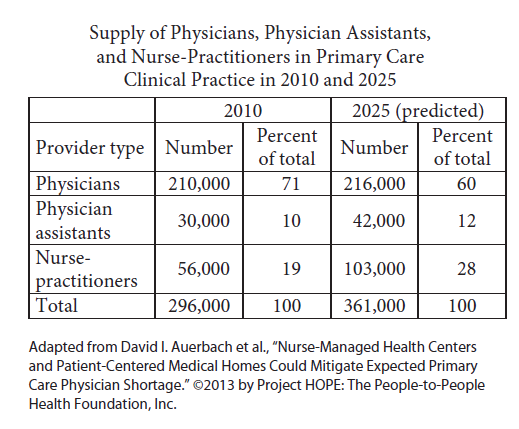
View SolutionThe Physician Assistant Will See You Now
23 The term “paramedics” refers to health care workers who provide routine and clinical services.–––––––––––––––––––––––––––––––––––––––––––––––––––––––––––––––––––––––––––––––––––––––––––––––––––––– While the pressures of an aging population, insurance reforms, and health epidemics have increased demand for care, the supply of physicians is not expected to 24 keep pace.––––––––––– The Association of American Medical Colleges predicts a shortage of over 90,000 physicians by 2020, by 2025, that number could climb to more than 130,000. In some parts of the country, shortages are already a sad fact of life. A 2009 report by the Bureau of Health Professions notes that although a fifth of the US population lives in rural areas, less than a tenth of US physicians serves that population. Because a traditionalist response to the crisis— 25 amping up–––––––––––– medical-college enrollments and expanding physician training programs—is too slow and costly to address the near-term problem, alternatives are being explored. One promising avenue has been greater reliance on physician assistants (PAs).
26 By virtue of 27 there–––––– medical training, PAs can perform many of the jobs traditionally done by doctors, including treating chronic and acute conditions, performing minor 28 surgeries: and––––––––––––––– prescribing some medications. However, although well 29 compensated earning in 2012 a median annual salary of $90,930,––––––––––––––––––––––––––––––––––––––––––––––––––––––––––––––––––––– PAs cost health care providers less than do the physicians who might otherwise undertake these tasks. Moreover, the training period for PAs is markedly shorter than 30 those for–––––––––– physicians—two to three years versus the seven to eleven required for physicians.
Physician assistants already offer vital primary care in many locations. Some 90,000 PAs were employed nationwide in 2012. Over and above their value in partially compensating for the general physician shortage has been their extraordinary contribution to rural health care. A recent review of the scholarly literature by Texas researchers found that PAs lend cost-efficient, widely appreciated services in underserved areas. 31 In addition,––––––––––––– rural-based PAs often provide a broader spectrum of such services than do their urban and suburban counterparts, possibly as a consequence of the limited pool of rural-based physicians.
Increasingly, PAs and other such medical practitioners have become a critical complement to physicians. A 2013 RAND Corporation report estimates that while the number of primary care physicians will increase slowly from 2010 to 2025, the number of physician assistants and nurse-practitioners in primary care will grow at much faster rates. 32 Both by merit and from necessity, PAs are likely to greet more 33 patience than––––––––––––––– ever before.
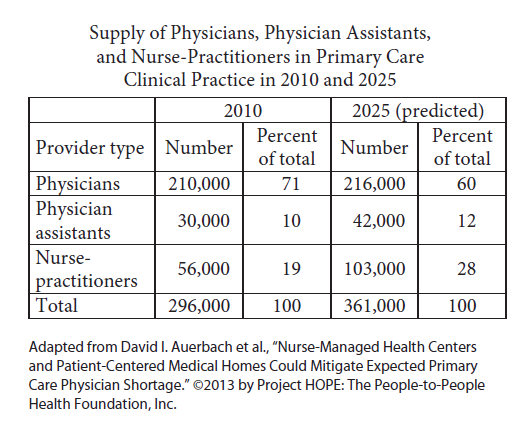
View SolutionThe Physician Assistant Will See You Now
23 The term “paramedics” refers to health care workers who provide routine and clinical services.–––––––––––––––––––––––––––––––––––––––––––––––––––––––––––––––––––––––––––––––––––––––––––––––––––––– While the pressures of an aging population, insurance reforms, and health epidemics have increased demand for care, the supply of physicians is not expected to 24 keep pace.––––––––––– The Association of American Medical Colleges predicts a shortage of over 90,000 physicians by 2020, by 2025, that number could climb to more than 130,000. In some parts of the country, shortages are already a sad fact of life. A 2009 report by the Bureau of Health Professions notes that although a fifth of the US population lives in rural areas, less than a tenth of US physicians serves that population. Because a traditionalist response to the crisis— 25 amping up–––––––––––– medical-college enrollments and expanding physician training programs—is too slow and costly to address the near-term problem, alternatives are being explored. One promising avenue has been greater reliance on physician assistants (PAs).
26 By virtue of 27 there–––––– medical training, PAs can perform many of the jobs traditionally done by doctors, including treating chronic and acute conditions, performing minor 28 surgeries: and––––––––––––––– prescribing some medications. However, although well 29 compensated earning in 2012 a median annual salary of $90,930,––––––––––––––––––––––––––––––––––––––––––––––––––––––––––––––––––––– PAs cost health care providers less than do the physicians who might otherwise undertake these tasks. Moreover, the training period for PAs is markedly shorter than 30 those for–––––––––– physicians—two to three years versus the seven to eleven required for physicians.
Physician assistants already offer vital primary care in many locations. Some 90,000 PAs were employed nationwide in 2012. Over and above their value in partially compensating for the general physician shortage has been their extraordinary contribution to rural health care. A recent review of the scholarly literature by Texas researchers found that PAs lend cost-efficient, widely appreciated services in underserved areas. 31 In addition,––––––––––––– rural-based PAs often provide a broader spectrum of such services than do their urban and suburban counterparts, possibly as a consequence of the limited pool of rural-based physicians.
Increasingly, PAs and other such medical practitioners have become a critical complement to physicians. A 2013 RAND Corporation report estimates that while the number of primary care physicians will increase slowly from 2010 to 2025, the number of physician assistants and nurse-practitioners in primary care will grow at much faster rates. 32 Both by merit and from necessity, PAs are likely to greet more 33 patience than––––––––––––––– ever before.
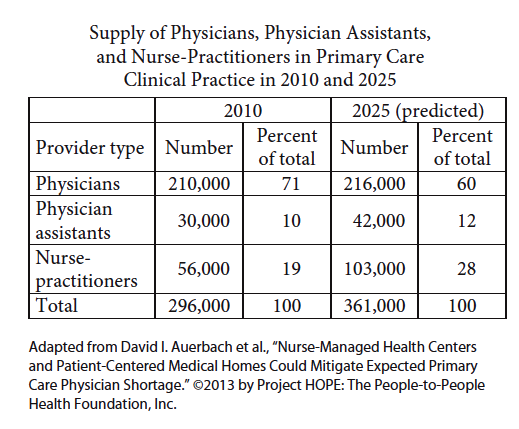
View Solution
